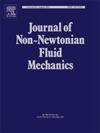基准几何中的弹粘塑性流动:2。绕受限圆柱体流动
IF 2.8
2区 工程技术
Q2 MECHANICS
引用次数: 0
摘要
我们计算了弹粘塑性(EVP)流体围绕圆柱体的二维流动,圆柱体对称地放置在平行于其轴的两个板之间。采用OpenFOAM软件,采用有限体积法求解Saramito-Herschel-Bulkley流体模型。与粘塑性材料一样,未屈服区域出现在圆柱体前方或后方的对称平面周围,就像圆柱体上方和下方的两个小岛,以及圆柱体上两个停滞点的极帽。最有趣的是,在某些条件下,在圆柱体的下游,预计在中间平面周围有一个细长的屈服区,夹在两个未屈服区之间。例如,当考虑阻塞比为0.5(圆柱体直径与通道宽度之比)且超过临界弹性模量(G>30Pa)时,Carbopol为0.1%时,出现了令人惊讶的结果。使用相同模型的近似半解析解表明,在上述区域,它是由应力大小的强烈变化引起的,根据材料的弹性,应力大小可能从上方或下方渐近地接近屈服应力。阻力系数随屈服应力和堵塞比的增大而增大,随材料弹性的增大而减小。随着屈服应力的增大,未屈服区逐渐扩大。当材料弹性增加时,它们也会膨胀,因为这允许材料在屈服之前进行更多的弹性变形。在圆柱体后面,所谓的“负尾流”出现,随着弹性的增加而变得更加强烈。此外,在蠕变流动条件下,通过降低弹性模量或将屈服应力增加到超过临界值,屈服面可能会出现阻尼振荡,甚至没有对称面也可能出现不规则形状。这两种特性主要在圆柱体后面产生这些图案,因为它们增加了弹性应力和流线的曲率,从而引发了纯粹的弹性不稳定性。本文章由计算机程序翻译,如有差异,请以英文原文为准。
Elasto-visco-plastic flows in benchmark geometries: II. Flow around a confined cylinder
We examine computationally the two-dimensional flow of elastoviscoplastic (EVP) fluids around a cylinder symmetrically placed between two plates parallel to its axis. The Saramito-Herschel-Bulkley fluid model is solved via the finite-volume method using the OpenFOAM software. As in viscoplastic materials, unyielded regions arise around the plane of symmetry well ahead or behind the cylinder, as two small islands located above and below the cylinder and as polar caps at the two stagnation points on the cylinder. Most interestingly, under certain conditions, an elongated yielded area around the midplane is predicted downstream of the cylinder, sandwiched between two unyielded areas. This surprising result appears, for example, with Carbopol 0.1 % when considering a blockage ratio of 0.5 (the ratio of the cylinder's diameter to the channel's width) and above a critical elastic modulus (). An approximate semi-analytical solution using the same model, in the region mentioned above reveals that it is caused by the intense variation of the stress magnitude there, which may approach the yield stress asymptotically either from above or below, depending on material elasticity. The drag coefficient on the cylinder increases with yield stress and blockage ratio but decreases with material elasticity. The unyielded regions expand as the yield stress increases. They also expand when material elasticity increases because this allows the material to elastically deform more before yielding. Behind the cylinder, the so-called "negative wake" appears which becomes more intense as elasticity increases. Furthermore, by decreasing the elastic modulus or increasing the yield stress beyond a critical value, the yield surface may exhibit damped oscillations, or irregular shapes even without a plane of symmetry, all under creeping flow conditions. Both properties generate these patterns mainly behind the cylinder, because they increase the elastic stresses and the curvature of the streamlines triggering a purely elastic instability.
求助全文
通过发布文献求助,成功后即可免费获取论文全文。
去求助
来源期刊
CiteScore
5.00
自引率
19.40%
发文量
109
审稿时长
61 days
期刊介绍:
The Journal of Non-Newtonian Fluid Mechanics publishes research on flowing soft matter systems. Submissions in all areas of flowing complex fluids are welcomed, including polymer melts and solutions, suspensions, colloids, surfactant solutions, biological fluids, gels, liquid crystals and granular materials. Flow problems relevant to microfluidics, lab-on-a-chip, nanofluidics, biological flows, geophysical flows, industrial processes and other applications are of interest.
Subjects considered suitable for the journal include the following (not necessarily in order of importance):
Theoretical, computational and experimental studies of naturally or technologically relevant flow problems where the non-Newtonian nature of the fluid is important in determining the character of the flow. We seek in particular studies that lend mechanistic insight into flow behavior in complex fluids or highlight flow phenomena unique to complex fluids. Examples include
Instabilities, unsteady and turbulent or chaotic flow characteristics in non-Newtonian fluids,
Multiphase flows involving complex fluids,
Problems involving transport phenomena such as heat and mass transfer and mixing, to the extent that the non-Newtonian flow behavior is central to the transport phenomena,
Novel flow situations that suggest the need for further theoretical study,
Practical situations of flow that are in need of systematic theoretical and experimental research. Such issues and developments commonly arise, for example, in the polymer processing, petroleum, pharmaceutical, biomedical and consumer product industries.

 求助内容:
求助内容: 应助结果提醒方式:
应助结果提醒方式:


